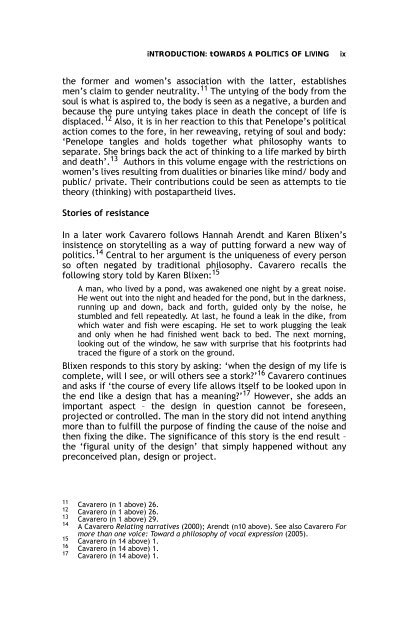Sex, Gender, Becoming - PULP
Sex, Gender, Becoming - PULP
Sex, Gender, Becoming - PULP
You also want an ePaper? Increase the reach of your titles
YUMPU automatically turns print PDFs into web optimized ePapers that Google loves.
iNTRODUCTION: tOWARDS A POLITICS OF LIVING<br />
ix<br />
the former and women’s association with the latter, establishes<br />
men’s claim to gender neutrality. 11 The untying of the body from the<br />
soul is what is aspired to, the body is seen as a negative, a burden and<br />
because the pure untying takes place in death the concept of life is<br />
displaced. 12 Also, it is in her reaction to this that Penelope’s political<br />
action comes to the fore, in her reweaving, retying of soul and body:<br />
‘Penelope tangles and holds together what philosophy wants to<br />
separate. She brings back the act of thinking to a life marked by birth<br />
and death’. 13 Authors in this volume engage with the restrictions on<br />
women’s lives resulting from dualities or binaries like mind/ body and<br />
public/ private. Their contributions could be seen as attempts to tie<br />
theory (thinking) with postapartheid lives.<br />
Stories of resistance<br />
In a later work Cavarero follows Hannah Arendt and Karen Blixen’s<br />
insistence on storytelling as a way of putting forward a new way of<br />
politics. 14 Central to her argument is the uniqueness of every person<br />
so often negated by traditional philosophy. Cavarero recalls the<br />
following story told by Karen Blixen: 15<br />
A man, who lived by a pond, was awakened one night by a great noise.<br />
He went out into the night and headed for the pond, but in the darkness,<br />
running up and down, back and forth, guided only by the noise, he<br />
stumbled and fell repeatedly. At last, he found a leak in the dike, from<br />
which water and fish were escaping. He set to work plugging the leak<br />
and only when he had finished went back to bed. The next morning,<br />
looking out of the window, he saw with surprise that his footprints had<br />
traced the figure of a stork on the ground.<br />
Blixen responds to this story by asking: ‘when the design of my life is<br />
complete, will I see, or will others see a stork?’ 16 Cavarero continues<br />
and asks if ‘the course of every life allows itself to be looked upon in<br />
the end like a design that has a meaning?’ 17 However, she adds an<br />
important aspect – the design in question cannot be foreseen,<br />
projected or controlled. The man in the story did not intend anything<br />
more than to fulfill the purpose of finding the cause of the noise and<br />
then fixing the dike. The significance of this story is the end result –<br />
the ‘figural unity of the design’ that simply happened without any<br />
preconceived plan, design or project.<br />
11<br />
Cavarero (n 1 above) 26.<br />
12 Cavarero (n 1 above) 26.<br />
13 Cavarero (n 1 above) 29.<br />
14<br />
A Cavarero Relating narratives (2000); Arendt (n10 above). See also Cavarero For<br />
more than one voice: Toward a philosophy of vocal expression (2005).<br />
15 Cavarero (n 14 above) 1.<br />
16<br />
Cavarero (n 14 above) 1.<br />
17 Cavarero (n 14 above) 1.
















